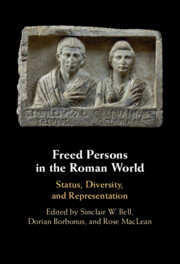Book contents
- Freed Persons in the Roman World
- Freed Persons in the Roman World
- Copyright page
- Contents
- Figures
- Table
- Contributors
- Acknowledgments
- Bibliographical Note
- Introduction
- 1 Permissu decurionum
- 2 Freed Public Slaves in Roman Italy and the Western Provinces
- 3 Fitting in by Decree
- 4 Doubling Up
- 5 The Cost of Ingratitude
- 6 Between Moral Slavery and Legal Freedom
- 7 Framing the Freed Person
- 8 Novel Evidence for Ancient Freed People
- 9 The Affects of Manumission
- General Bibliography
- Index
- References
9 - The Affects of Manumission
Racial Melancholy and Roman Freed Persons*
Published online by Cambridge University Press: 16 May 2024
- Freed Persons in the Roman World
- Freed Persons in the Roman World
- Copyright page
- Contents
- Figures
- Table
- Contributors
- Acknowledgments
- Bibliographical Note
- Introduction
- 1 Permissu decurionum
- 2 Freed Public Slaves in Roman Italy and the Western Provinces
- 3 Fitting in by Decree
- 4 Doubling Up
- 5 The Cost of Ingratitude
- 6 Between Moral Slavery and Legal Freedom
- 7 Framing the Freed Person
- 8 Novel Evidence for Ancient Freed People
- 9 The Affects of Manumission
- General Bibliography
- Index
- References
Summary
This contribution brings racial affect theory to bear on the literary representation of Roman manumission, in the process developing new critical tools for the history of Roman slavery as a mechanism for racialization. Through a close reading of the freed man Hermeros’ diatribe in the Cena Trimalchionis, I argue for the centrality of racial melancholy to the discursive and social forms by which manumission came to be experienced and figured. The operation of this racial melancholy in Petronius’ text is decomposable into two distinct, but complementary, sentimental performances: paranoia on the one hand, and compulsion into (evasive) autobiographical confession on the other. The interlinking of these performances within Hermeros’ speech generates a melancholic affect, which I conceptualize as a disposition for managing and negotiating the grief of enslavement and manumission. In formulating and grounding this claim, I hope to clear a space for mutually enriching exchange among historians of Roman slavery, historians of premodern race, and those literary critics and cultural theorists who have been influential in setting the terms for the “affective turn.”
Keywords
- Type
- Chapter
- Information
- Freed Persons in the Roman WorldStatus, Diversity, and Representation, pp. 242 - 277Publisher: Cambridge University PressPrint publication year: 2024

